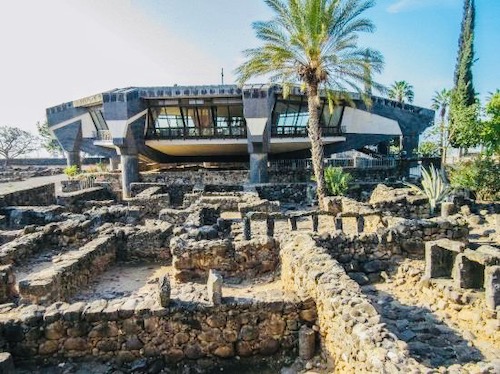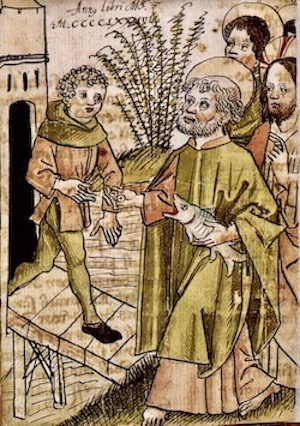Archaeologists have found in 1968 the ruins of a large house in ancient Capernaum they believe to be the home of Peter. It is in a cluster of some twelve houses dating from the 1st century AD, close to the ruins of a synagogue. The walls of the home were plastered and painted with stylized flowers, pomegranates, figs, geometric figures and hundreds of crosses. On the limestone floor were found many fragments of votive lamps, signifying this house had been singled out from earliest times for special veneration. On the walls of the home were graffiti in many languages: “Lord Jesus Christ, Help;” “Christ Have Mercy;” “Most High God.”
“Beneath the foundations of this octagonal Byzantine martyrium church at Capernaum (below), archaeologists made one of the most exciting Biblical archaeology discoveries: a simple first-century A.D. home that may have been the house of Peter, the home of Jesus in Capernaum. Photo: Garo Nalbandian.”

There are 124 inscriptions in Greek, 18 in Syriac (one mentioning the Eucharist), 15 in Hebrew and 2 in Latin. One in Latin says, “Peter, Helper Of Rome.” So many inscriptions in so many languages suggest this was a place of pilgrimage for early believers.
When Emperor Constantine’s mother, Helena, made a tour of Palestine in c. 325-327, this home in Capernaum was pointed out to her as the home of Peter. She made the home into a church that was visited 50 years later by the Spanish pilgrim Egeria who wrote in the diary of her pilgrimage: “In Capernaum the house of the prince of the apostles became a church. The walls, however, of the house have remained unchanged to the present day.”
Jesus lived in Capernaum (probably with Peter) and performed some of his most memorable miracles there: the healing of Peter’s mother-in-law (Mt. 8:14-17); the healing of the palsied man whose friends lowered him down from the roof of a home where Jesus was teaching (Mt. 9:1-8; Mark 2:1-12; Luke 4:40,41); the raising from the dead of Jairus’ daughter (Mt. 9:18, 23-25; Mark:22; Luke 8:40-56); the woman healed from an issue of blood (Mt. 9:20-22); the healing of the man with a withered hand (Mt. 12:9-14; Luke 6:6-11) the healing of two blind men (Mt. 9:27-30); the healing of a mute man (Mt. 9:32,33); the miracle of the coin used to pay the Temple tax (Mt. 17:-27).

It is interesting to note that so many of the miracles done in Capernaum are recorded by the eyewitness testimony of Matthew who was a native of Capernaum. Of particular interest to the tax collector Matthew must have been Jesus’ command to Peter in Matthew 17:24: “…go to the lake and throw out your line. Take the first fish you catch; open its mouth and you will find a four-drachma coin. Take it and give it to them (the Temple tax collectors) for my tax and yours.” It is certain that Matthew had never seen any kind of tax, Temple or Roman, paid in that fashion.
CLICK HERE for article on Matthew
In Capernaum Jesus healed the servant of the Gentile Roman centurion who was in charge of the small military garrison there and had built the local synagogue for the Jews. The synagogue was very close to Peter’s home:
“When Jesus had finished saying all this in the hearing of the people, he entered Capernaum. There a centurion’s slave, whom his master valued highly, was sick and about to die. The centurion heard of Jesus and sent some elders of the Jews to him asking him to come and heal his servant. When they came to Jesus, they pleaded earnestly with him, ‘This man deserves to have you do this, because he loves our nation and has built our synagogue.’ So Jesus went with them. He was not far from the house when the centurion sent friends to say to him: ‘Lord, don’t trouble yourself, for I do not deserve to have you come under my roof. That is why I did not even consider myself worthy to come to you. But say the word, and my servant will be healed. For I myself am a man under authority, with soldiers under me. I tell this one, Go, and he goes; and that one, Come, and he comes. I say to my servant Do this, and he does it.’ When Jesus heard this, he was amazed at him, and turning to the crowd following him, he said, ‘I tell you, I have not found such great faith even in Israel.’ Then the men who had been sent returned to the house and found the servant well.” Luke 1:1-10
It was in this synagogue in Capernaum, built by a Roman centurion sympathetic to the Jews and to Jesus, that Jesus would make one of His most controversial claims.
After the suppertime miracle of the loaves and fishes, the next morning the thousands of well-fed people realized Jesus was not there. Some crossed the Sea of Galilee in boats from Tiberias and found Him in that synagogue in Capernaum. They began to question Him: How and when did you get to Capernaum? What works does God require of us? Will you do a miracle like Moses did when he made manna come out of heaven to feed our forefathers? What will you do to make us believe in you? Jesus rebuked them:
“…you are looking for me…because you ate the loaves and had your fill. Do not work for food that spoils, but for food that endures to eternal life….it is not Moses who has given you bread from heaven. For the bread of God is he who comes down from heaven and gives life to the world. ‘Sir,’ they said, ‘from now on give us this bread.’ Then Jesus declared, ‘I am the bread of life. He who comes to me will never go hungry, and he who believes in me will never be thirsty’….At this the Jews began to grumble about him because he said, ‘I am the bread that came down from heaven‘….‘Stop grumbling among yourselves!’ Jesus answered….‘I am the bread of life. Your forefathers ate the manna in the desert, yet they died. But here is the bread that comes down from heaven….I am the living bread that came down from heaven. If anyone eats of this bread, he will live forever. This bread is my flesh, which I will give for the life of the world….unless you eat the flesh of the son of Man and drink his blood, you have no life in you….For my flesh is real food and my blood is real drink….Just as the living Father sent me and I live because of the Father, so the one who feeds on me will live….This is the bread that came down from heaven. Your forefathers ate manna and died, but he who feeds on this bread will live forever.’” John 6:25-59
A lot had happened in a twenty-four hour period. Jesus had healed many people, had fed the five thousand, had walked on the waters of the Lake and then had a lengthy, contentious debate in the Capernaum synagogue. He had declared Himself to be the living fulfillment prefigured by the manna/bread from heaven in the wilderness. He had asserted that He is the bread of life and that in order to have eternal life, you had to eat His flesh and drink His blood. He was establishing the new covenant:

“While they were eating, Jesus took bread, gave thanks and broke it, and gave it to his disciples, saying, ‘Take it; this is my body.’ Then he took the cup, gave thanks and offered it to them, and they all drank from it. ‘This is my blood of the covenant which is poured out for many.’” Mark 14:22-24
He was saying to these astonished and offended Jews in Capernaum that He was the living bread that comes from heaven, the eternal daily nourishment given by God versus the temporal manna given to their starving ancestors in the Desert of Sin (Exodus 16:1-4). He hallowed the wine as the life-sustaining water from the rock given to the Jews when they were dying of thirst in the desert (Exodus 17:1-7). Bread and water; body and blood. He said He was the embodiment of the desert miracles that had kept their people alive.
It had been a crucial twenty-four hour period in which Jesus radically defined who He was by His miracles and His words. It was a pivotal time that forced His followers to ask the question, Who in the name of God is this man?! Many of His followers balked at His saying, “unless you eat the flesh of the son of Man and drink his blood, you have no life in you.” Some of His disciples said, “This is a hard teaching. Who can accept it?” So “from this time many of his disciples turned back and no longer followed him.” (John 6:60, 66) Jesus had about a year before He would be crucified. He was not mincing words. He was separating the wheat from the chaff.
The New Testament Christians graced the walls of the catacombs with frescoes portraying their celebration of the events of that 24-hour period in Galilee when Jesus took fish, broke bread and fed thousands; declared His Body, bread; His Blood, wine; Himself the Ichthus—the Christ, Son of God, Savior.
CLICK HERE for article on the ICHTHUS
Through the symbolical rites of Baptism and Communion the Christian faith washes away sin and maintains spiritual purity.—Sandra Sweeny Silver
